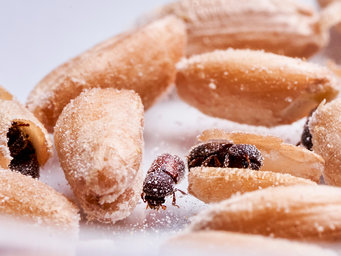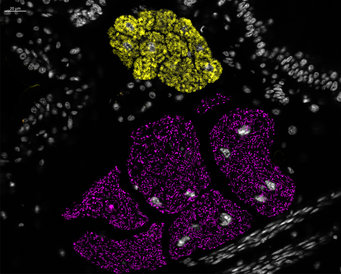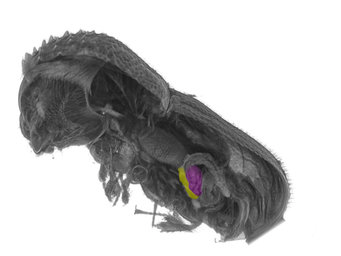A Dual Symbiosis Supports Cuticle Formation in Wood-Feeding Beetles
Two bacterial partners supply auger beetles with vital nutrients for the synthesis of a sturdy exoskeleton
Two bacterial partners supply auger beetles with vital nutrients for the synthesis of a sturdy exoskeleton
APRIL 24, 2023
During the course of evolution, wood-feeding beetles of the auger beetle family (Bostrichidae) established and maintained associations with the two nutritional symbionts Shikimatogenerans bostrichidophilus and Bostrichicola ureolyticus. In a recent study, researchers from the University of Mainz and the Max Planck Institute for Chemical Ecology in Jena, Germany, demonstrate that these two related bacteria specialize on nutrient recycling and provisioning metabolites that are involved in the synthesis of a strong cuticle, a key adaptation when surviving in dry environments. (ISME Journal, May 2023, DOI: 10.1038/s41396-023-01415-y).

The powderpost beetle Dinoderus porcellus is one of the studied species of the Bostrichidae family that maintains a dual symbiosis with two nutritional symbionts. The bacterial partners provide the beetle with important components for the formation of a sturdy and protective exoskeleton.
© Anna Schroll
Beetles usually rely on the help of bacterial partners to survive. These symbioses can have different functions. Bacterial symbionts may help digest plant material, make the beetles more resistant to plant defenses, or provide supplemental nutrients when beetles as an adaption to nutrient-poor habitats. In several beetle species, it has already been described that their bacterial allies provide important components for the formation of the cuticle, the insect's exoskeleton.
"Studies on the importance of beetle symbionts for the recycling of nitrogen and the synthesis of certain amino acids as key components for stabilizing the cuticle are still a young field of research," emphasizes Julian Kiefer from Johannes Gutenberg University Mainz (JGU), the first author of the study.
A strong and sturdy cuticle as a key adaptation to adverse biotic and abiotic factors
The cuticle, a hard armor composed of cross-linked protein and chitin polymers, is the primary defense of insects against predators and pathogens, but also averse abiotic factors such as extremely dry environments. Previous studies already identified the importance of specialized symbiont contributions to the cuticle synthesis of beetles and ants. The removal or inhibition of these symbionts reduced cuticle thickness and rendered beetles more susceptible to desiccation, predation and pathogen attack (see “A beetle’s Achilles heel”, press release, May 11, 2021).
The current work investigated the family of auger beetles (Bostrichidae) which includes wood and grain feeding species. From histological drawings made a century ago, it was known that some auger beetle species are associated with one or two bacterial symbionts found in specific organs of the beetles. To find out which important metabolites the symbionts provide to the beetles, the research team from the University of Mainz and the Max Planck Institute for Chemical Ecology, in collaboration with partners at the National Institute of Advanced Industrial Science and Technology in Japan, obtained genome sequences from different beetle species of the auger beetle family and their symbiotic bacteria.
"The biggest challenge for us was the auger beetle genera with two symbionts. Since they are relatively closely related, it was difficult to separate the genomes of the two symbionts. To do this, we had to rely on very recent amplification free, long-read sequencing technologies to overcome this challenge," says study leader Tobias Engl from the Max Planck Institute for Chemical Ecology, describing the methodological approach.

Localization of the two bacterial symbionts Shikimatogenerans bostrichidophilus (magenta) and Bostrichicola ureolyticus (yellow) in the powderpost beetle Dinoderus porcellus via Fluorescence in situ hybridization (FISH).
© Julian Kiefer, JGU Mainz
The results show that almost all auger beetle species are associated with symbiotic bacteria of the strain Shikimatogenerans bostrichidophilus. This symbiont was acquired by a common ancestor of all auger beetles and was probably maintained throughout the family. It co-evolved with the beetle host to produce the precursors of the aromatic amino acid tyrosine. In contrast, the second symbiont, Bostrichicola ureolyticus, was probably acquired by the ancestors of only two subfamilies within the auger beetles – and lost at least once within each subfamily. This symbiont is able to recycle nitrogen and produce another amino acid, lysine. In doing so, it provides additional nutrients for the host and presumably allows it to colonize new ecological niches. Nitrogen is a limited and thus valuable nutrient for most herbivores. Tyrosine and lysine are of particular importance for the formation of a strong and sturdy exoskeleton. They are responsible for cross-linking the cuticle, giving it rigidity, but also for pigments that color the cuticle and make it less permeable to water. A stronger cuticle protects the beetles better against natural enemies, but also against desiccation in harsh or extremely dry habitats.

Localization of the two bacterial symbionts Shikimatogenerans bostrichidophilus (magenta) and Bostrichicola ureolyticus (yellow) bacteriomes via micro-computertomographic reconstruction in the powderpost beetle Dinoderus porcellus.
© Camila Fiori Pereira, MPI-CE
Ancient associates – unusual dual symbioses
The two discovered symbiotic bacteria in auger beetles represent two of the most specialized species within the insect associated group of Bacteroidota bacteria. Related members are obligate symbionts of cockroaches, cicadas, scale insects and mealybugs, but retained the capability to synthesize a broader set of nutrients. However, the dual symbiosis discovered in auger beetles is uncommon for multiple reasons. “Dual symbioses have so far only been described within the cicadas and related insects. They usually include phylogenetically different microorganisms, and the second symbiont usually replaces eroded metabolic capabilities of the older symbiont,” explains Martin Kaltenpoth, head of the Department of Insect Symbiosis at the Max Planck Institute for Chemical Ecology.
In contrast, this study is the first to show a case of dual symbiosis with closely related nutritional symbionts in a beetle family. Here, the beetles appear to have acquired both bacterial partners independently. The convergent evolution of a symbiosis with different bacteria for the provision of vital components for cuticle synthesis in the studied species from the auger beetle family highlights its importance for beetles in general. The specific contributions of the bacterial partners from this dual symbiosis represent species-specific adaptations that enabled the beetles to thrive in their respective nutritional niches.
Publication: Julian Simon Thilo Kiefer, et al., Cuticle supplementation and nitrogen recycling by a dual bacterial symbiosis in a family of xylophagous beetles, The ISME Journal (2023). DOI: 10.1038/s41396-023-01415-y.
Original Story Source: Max Planck Institute for Chemical Ecology

 Alerts Sign-up
Alerts Sign-up